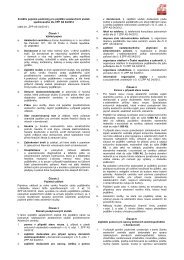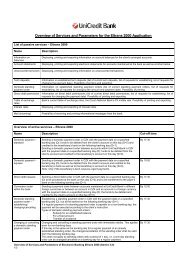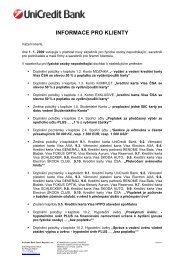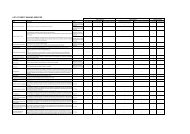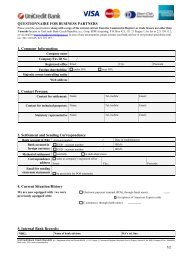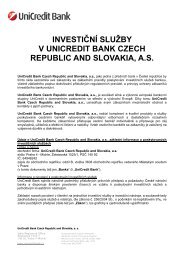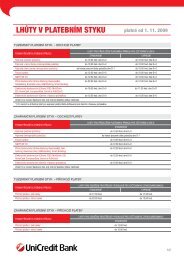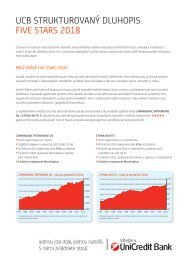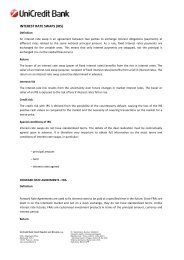Annual report 2004 (PDF, 4141 kB) - Unicredit Bank
Annual report 2004 (PDF, 4141 kB) - Unicredit Bank
Annual report 2004 (PDF, 4141 kB) - Unicredit Bank
You also want an ePaper? Increase the reach of your titles
YUMPU automatically turns print PDFs into web optimized ePapers that Google loves.
26 FINANCIAL RISKS<br />
(a)<br />
Strategy in using financial instruments<br />
The <strong>Bank</strong>’s activities are principally related to the use of financial instruments. The <strong>Bank</strong><br />
accepts deposits from customers at both fixed and floating rates and for various periods<br />
and seeks to earn above average interest margins by investing these funds in high quality<br />
assets. The <strong>Bank</strong> seeks to increase these margins by consolidating short-term funds<br />
and lending for longer periods at higher rates whilst maintaining sufficient liquidity to meet<br />
all claims that might fall due.<br />
The <strong>Bank</strong> also seeks to raise its interest margins by obtaining above average margins, net<br />
of provisions, through lending to commercial and retail borrowers with a range of credit<br />
standing. Such exposures involve not just on-balance sheet loans and advances but the <strong>Bank</strong><br />
also enters into guarantees and other commitments such as letters of credit and other<br />
contractual liabilities.<br />
The <strong>Bank</strong> also trades in financial instruments where it takes positions in traded and over<br />
the counter instruments including derivatives. The <strong>Bank</strong> policy allows to use derivatives only<br />
for hedge <strong>Bank</strong>’s position or for clients deals. The Board places trading limits on the level of<br />
exposure that can be taken in relation to both overnight and intra-day market positions.<br />
(b)<br />
Credit risk<br />
The <strong>Bank</strong> structures the levels of credit risk it undertakes by placing limits on the amount<br />
of risk accepted in relation to one borrower, or groups of borrowers, and to geographical<br />
and business segments. Such risks are monitored on a revolving basis and are subject to an<br />
annual or more frequent review. Limits on the level of credit risk by industry sector and by<br />
country are approved by the Board of Directors.<br />
In the course of <strong>2004</strong>, the <strong>Bank</strong> implemented a new internal rating system for corporate<br />
banking segment. The internal rating system was developed in cooperation with the <strong>Bank</strong>'s<br />
parent company. The internal rating system reflects both the client's financial system and<br />
qualitative indices, such as the quality of management or position of the respective person on<br />
the market. Individual entities are classified into nine classes. Based on the internal rating<br />
system, clients classified from 6 to 8 are included into the group of watched loans. Class 9 has<br />
been reserved for non-performing loans.<br />
52




